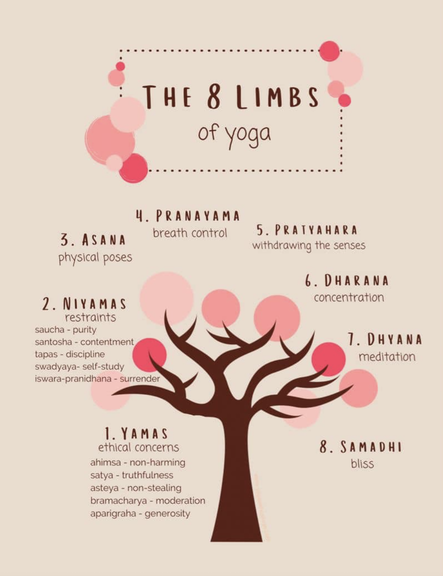|
4/10/2018 1 Comment Taking yoga beyond your mat!Below is some helpful information, and an explanation on the eight limbs of yoga. As you may or may not know your yoga practice is much more than the physical postures (asana). Once you've been on the mat for a while, your practice will start to take on an additional purpose as the principles of yoga become your thoughts, words and actions.
The "Eight Limbs of Yoga" listed below can serve as a guide for living a meaningful and purposeful life. 1. YAMAS are ethical considerations to help guide interactions with others
2. NIYAMAS are practices that inform self-discipline and worldview.
3. ASANA refers to the physical postures practiced in yoga.
4. PRANAYAMA refers to breathing.
5. PRATYAHARA is the practice of withdrawing from external stimuli to enhance internal awareness.
6. DHARANA is the practice of intense concentration.
7. DHYANA is the state of being keenly aware, yet without focus.
8. SAMADHI is a state of ecstasy.
https://www.gaia.com/lp/content/the-8-limbs-of-yoga-explained
1 Comment
8/13/2019 04:17:32 am
Most of us think it's always about all these physical attributes.Yoga is not about that believe it or not. You just need to focus on the presence of a higher being. It's the only thing that can save you from all the empty promises of the material world. If you are only doing this to lose weight, you are totally missing the point. Yoga is about being at peace with yourself and you can only do this if you are at peace with your relationship with God. You can't find God anywhere. You can only speak to him through your own heart.
Reply
Leave a Reply. |
AuthorBarb is married and lives in London, Ontario. She has two wonderful step-daughters and two amazing step-grand daughters. Barb enjoys travelling and seeks out UNESCO World Heritage destinations around the globe. The history, culture & people she encounters along the way inspires her optimistic attitude and outlook on life. Categories |



 RSS Feed
RSS Feed
